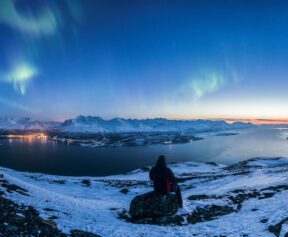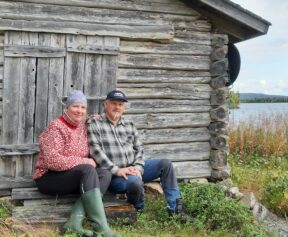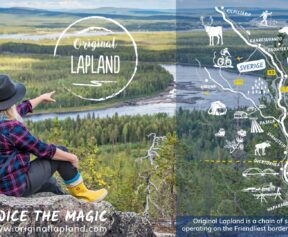See the text in the original language
Ernst Isaksen is a former teacher and politician. After he retired he started to focus his interest in local history. In this interview he tell’s two stories that that tells about Kven immigration to Nord-Troms and how they have been seen through history.
This interview is in Norwegian.
My name is Ernst Isaksen and I was born and raised in Nord-Troms, in what is now Nordreisa municipality. After I retired I could focus on my interest in local history. The history is particularly important in this region, because of the ethnic groups that have, and still, live up here. This has created a unique culture. When I was young, people had stronger ethnic identities, the Sámi and Kven were perhaps more noticeable.
Read moreErnst Isaksen is a former teacher and politician. After he retired he started to focus his interest in local history. In this interview he tell’s two stories that that tells about Kven immigration to Nord-Troms and how they have been seen through history.
This interview is in Norwegian.
My name is Ernst Isaksen and I was born and raised in Nord-Troms, in what is now Nordreisa municipality. After I retired I could focus on my interest in local history. The history is particularly important in this region, because of the ethnic groups that have, and still, live up here. This has created a unique culture. When I was young, people had stronger ethnic identities, the Sámi and Kven were perhaps more noticeable.
a Kven myth
This story is more of a myth, from an island outside of here. It is about the big and strong Kven who had to fight the sea draug. The draug was a troll living in the sea which could be dangerous for people, particularly for people at sea. Back in the days, everyone feared the draug.
There was a couple living on Draugsnes on an island called Arnøy. Marit and Johannes Hansa were their names. Johannes Hansa was a big and strong man. He was a fisherman. Johannes once came ashore with a rather good catch. When cutting fish Johannes saw a piece of meat inside the stomach of one of the fish. Johannes took the meat and made fun of it and threw it to the sea and shouted “This is for you, Gammel-Erik” – which is another name for the devil. They notice that an duck picks up the piece of meat. The bird carries the meat towards the sea and Johannes says, laughing: “That was Gammel-Erik picking up his meat”.
When night comes Johannes needed to go to the loo, someone grabbed him by the neck. He was dragged towards the sea. Eventually his wife woke up and she notices that her husband is not in bed. She sees her husband wandering up and down by the sea, being pushed and dragged by something she can’t see. She shouts for her husband and the invisible creature lets go.
This story shows how people believed in these creatures, probably quite long into the 1900s. And that the Kven, despite being big and strong, had no chance when up against the powers of the underworld. These stories were normally connected to named persons who have lived, who are real. Beliefs in super natural powers and the otherworldly creatures and things were strong back then. People were afraid of all these things they didn’t understand.
Rekar-kvener – wandering Kvens
The another story is about so called “Rekar-kvener”, meaning wandering Kvens, who didn’t belong or live anywhere in particular. They could be a bit sneaky and up to no good, some of them were intelligent people who managed to trick people. Warnings would be given when people were gathered at church and in the local newspaper that a “Rekar-Kven” had arrived and that people needed to be aware.
As most of those Kvens were quire innocent, this is a much darker and ugly story, as two Kvens ended up killing five people in a village on the other side of the mountain from here. One of them came from Kengis Bruk, Pajala. Moses, belonged to a family that had moved to Olderdalen in Nord-Troms. Mikkel, was still living in Pajala. These two knew that there were some very rich families in Troms county and they stole valuable things and soon they were worried that they would get caught. So they stole a boat and ended up in Nordreisa, Reisadalen Valley, where Moses’ aunt lived.
On the other side of the mountain lived a lady who owned all of Nord-Troms. Moses’ aunt encouraged them going there to steal valuables, as she felt the lady had treated her badly. This lady was 23 at the time, but already a widow. It turned out that the lady, Madam Hyssing, was away at the time when Moses and Mikkeli arrived. They hid in the woods and one night they broke into the farms outbuildlings and storages. – they stole food, clothing and whatever they could find. They also found a gun.
Then they found some alcohol, which gave them more courage to break into the main house to steal silver and money. One of the servants, young girl, recognised Moses. They fled and went back to the wilderness far up Reisadalen, but they soon ran out of food. They made a raft and floated down the Reisa river, but stranded on a small island in the river, since called Mosesholmen.
They were discovered and arrested. They were brought back to Madam Hyssings farm as that is where the jail was. The men were sentenced to imprisonment at 14. September 1790.
The jail was cold and dark, they hardly had any food and clothing. Eventually they managed to break out of their prison. They broke into a cellar and found alcohol. To get food, they broke into an attic where they killed two female servants. After that they stole a boat and rowed out the Lyngen fjord and headed south past Tromsø, where they were caught again and arrested.
They faced murder charges and were facing the death penalty. They were put back into their jail and sat until Easter 1791 when they escaped again and killed two guards. Also another servant was killed. This time they escaped south towards Storfjord and over the mountain to Enontekiö, where they get caught. Eventually there was a trial and sentence, which was dear penalty. Also their right hand were to be cut off while they were still alive. This was a punishment for stealing. Then their heads were to be cut off, their bodies to be hung and shot, and their heads to be put on stakes.
The punishment was carried out on the 29 December 1792. When you travel south from here, you can see to small islands where the execution place was. Executions of murderers were always carried out on small islands up here. Their bodies are probably still there, at least one of them. Moses, the eldest, died in jail just before the execution. Mikkel, the youngest, were having his confirmation before execution.
Stories reflecting the history and social status
These stories tells about a horrible revenge culture. The story and the court records tells about society 200 years ago. It was a society with a very powerful owner of all land, who rented out to people belonging to one of three groups: Norwegians who were highest, the Kven who were respected and the Sámi, who were lowest. A clear distinction was made between these three, a thought that we don’t have today. Nobody here owned their own land.
You could say that the Sea Sámi had the least protection through the laws at the time, because they lived on farms that they had run for generations. Most of Troms was first sold to a Dutch land owner, then it was divided into three. These owners started land registries, which meant that they claimed to own land that was already occupied, but that had never been entered into any paperwork. So the Sea Sámi here and elsewhere have been badly treated through this.
Nord-Troms preserved the old traditions longer, but today they are more similar. Dialects are also disappearing. When I was little, you could hear who was Kven and Sámi by they way they spoke Norwegian. Traces of Kven survive in Reisadalen, but it is disappearing.
Local stories like this are very interesting to people. This tale was made into a theatre play which was shown in Oslo and Tromsø.
HideErnst Isaksen er tidligere lærer og politiker. Etter at han ble pensjonert, har han viet tid til sin interesse for lokalhistorie. I intervjuet forteller han to historier om kvener som kom til regionen, og hvordan kvenene historisk sett er blitt oppfattet.
Country of origin: Norway





